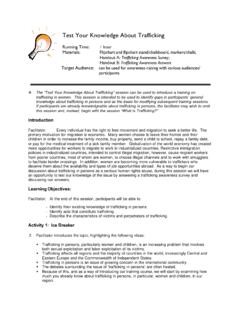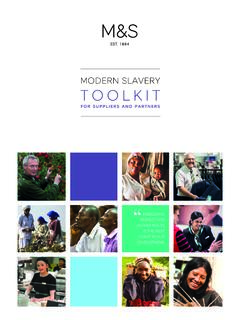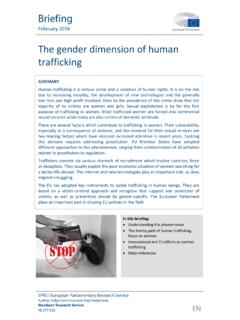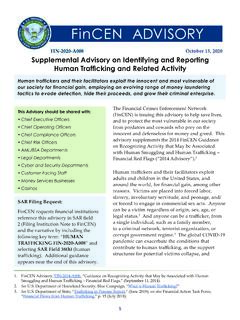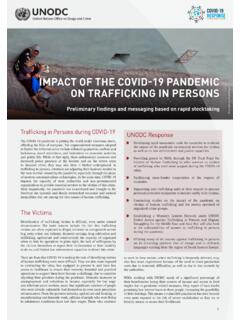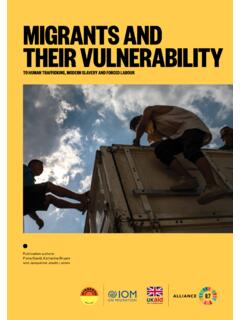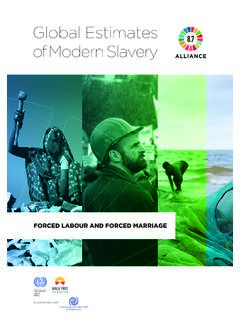Transcription of AN ANALYSIS OF THE SITUATION OF FILIPINO DOMESTIC …
1 InternationalLabourOrganizationAN ANALYSISOF THE SITUATIONOF FILIPINODOMESTIC WORKERSN icole J. SayresILO Special Action Programme to Combat Forced Labour:Mobilizing Action for the Protection of DOMESTIC Workersfrom Forced Labour and trafficking in Southeast AsiaAn ANALYSIS of the SITUATION of the FILIPINO DOMESTIC Workers2 ForewordDomestic work is one of the most important sourcesof employment for Philippine women both in thecountry and abroad. About one-quarter of Philippineworkers deployed overseas every year enter domesticservice. Concern for their safety and protection fromabuse is particularly strong in the Philippines in theaftermath of the execution of Flor Contemplacion, aPhilippine DOMESTIC worker in Singapore in 1995. Indeed,the hidden nature of DOMESTIC work within the privatesphere of the employers household and the informalemployment arrangements often practiced, make domesticworkers particularly vulnerable to exploitation, and in somecircumstances, to forced labour and International Labour Organization promotes decentwork for all, including those employed in households.
2 ItsDeclaration on Fundamental Principles and Rights at Workadopted in 1998, obligates member States to respect,promote and realize freedom of association and the right tocollective bargaining, the elimination of all forms of forcedor compulsory labour, the effective abolition of child labour,and the elimination of discrimination in respect ofemployment and occupation. The ILO s Special ActionProgramme to combat Forced Labour (SAP-FL) under theProgramme on Promoting the Declaration aims to promoteunderstanding and effective action to eliminate forcedlabour and trafficking . One of its activities is to extendsupport to ILO member States in adopting appropriatepolicy and programmes to protect DOMESTIC workers fromthe threat of forced labour and human trafficking . TheSituation ANALYSIS presented in this paper forms thebackdrop for the ILO s technical cooperation in thePhilippines under the project entitled Mobilizing Action forthe Protection of DOMESTIC Workers from Forced Labourand trafficking in Southeast Asia.
3 This paper examines the rights and workingconditions of Philippine DOMESTIC workers employed inthe country and abroad. It reveals that there are markeddifferences between migrant and local DOMESTIC workersin educational qualifications and work experience. Thefact that they form two distinct pools of labour certainlyhas implications for policies and programmes ondomestic work. The discussion surrounding the BatasKasambahay Bill raises important issues of minimumwage and social security for DOMESTIC workers, anoccupation that is in many other countries excluded fromthe ambit of labour law. Organizations of domesticworkers in the Philippines represent a ray of hope - astheir voice and representation increase, they will gain inrecognition and fray a path towards decent workingconditions for themselves. Support to such organizationsis the main focus of ILO s technical cooperation ondomestic study was carried out by the consultant, NicoleSayres, under the supervision of Naomi Cassirer, theGender Specialist in ILO Manila.
4 It has been updated byAsha D Souza, Anti- trafficking Specialist of the SpecialAction Programme to Combat Forced Labour, ILOD eclaration Programme, Geneva, with the help ofRicardo Casco, National Project Coordinator, ILOM anila. It expresses the views of the author, which arenot necessarily those of the work being a major source of incomefor poor women, the ILO firmly believes that regulationof working conditions combined with empowermentof organizations of DOMESTIC workers can make animportant contribution to gender equity and BlenkDirector,ILO Sub-regional Office, ManilaRoger PlantHead, Special Action Programmeto Combat Forced LabourAn ANALYSIS of the SITUATION of the FILIPINO DOMESTIC Workers3 FOREWORD2 ACRONYMS41 INTRODUCTION52 RESEARCH Literature Key Informant Voices of DOMESTIC Helpers63 SCOPE OF DOMESTIC DOMESTIC Work in the Philippines7 Table 1 Number of DOMESTIC Helpers by Region: January - October DOMESTIC Work Overseas9 Table 2 Top Destination Countries* of FILIPINO DOMESTIC Helpers and9 Related Workers (New Hires)Table 3 Sending Regions of Deployed FILIPINO DOMESTIC Helpers (New Hires)
5 10 Table 4 Profiles of Local and Overseas FILIPINO DOMESTIC Workers114 LEGISLATIVE AND REGULATORY International National trafficking in Forced Women s Legislation155 RECRUITMENT AND Local Overseas Training for DOMESTIC Workers196 CONDITIONS OF WORK IN THE Terms of DOMESTIC Violations and Forced Labour and Trafficking237 CONDITIONS OF WORK IN SOUTHEAST Terms of Overseas Violations and Overseas Forced Labour and Trafficking258 REPORTING OF In the Overseas269 NATIONAL INFRASTRUCTURE TO ADDRESS ISSUES RELATINGTO DOMESTIC Government Inter-Agency Workers Employer and Employment Non-Government International Donors3110 OTHER and Ethnic CHALLENGES3312 RECOMMENDATIONS3413 CONCLUSION36 ANNEX 1:KEY INTERVIEWS AND FOCUS GROUP DISCUSSIONS37 ANNEX 2:BIBLIOGRAPHY39 TABLE OF CONTENTSAn ANALYSIS of the SITUATION of the FILIPINO DOMESTIC Workers4 ACILSA merican Center for International Labor SolidarityADBA sian Development BankAusAIDA ustralian Agency for International DevelopmentBBKB antay Bata sa Komunidad (or Child Watch Community)
6 BCPCB arangay Council for the Protection of ChildrenBLEB ureau of Local EmploymentBWCB ureau of Working ConditionsBWYWB ureau of Women and Young WorkersCATW-AP Coalition Against trafficking of Women - Asia PacificDFAD epartment of Foreign AffairsDILGD epartment of Interior and Local GovernmentDOJD epartment of JusticeDOLED epartment of Labor and EmploymentDSWDD epartment of Social Welfare and DevelopmentECOPE mployers Confederation of the PhilippinesECPATEnd Child Prostitution, Child Pornography, and the trafficking of Children for SexualPurposeFFWF ederation of Free WorkersIACATI nter-Agency Council Against TraffickingILOI nternational Labour OrganizationIOMI nternational Organization for MigrationIPECI nternational Programme on the Elimination of Child LabourJICAJ apan International Cooperation AgencyMFAM igrant Forum in AsiaNBIN ational Bureau of InvestigationNCRN ational Capital RegionNCRFWN ational Commission on the Role of FILIPINO WomenNGONon-Government OrganizationNSON ational Statistics OfficeOFWO verseas FILIPINO WorkerOUMWAO ffice of the Undersecretary for Migrant Workers AffairsOWWAO verseas Workers Welfare AdministrationPMRWP hilippine migrants Rights WatchPNPP hilippine National PolicePOEAP hilippine Overseas Employment AdministrationPOPEAP hilippine Organization of Private Employment AgenciesRARepublic ActSAP-FLSpecial Action Programme to Combat Forced LabourSBMS agip-Batang Manggagawa (or Rescue Child Labourers)
7 SMCS calabrini Migration CenterSUMAPIS amahan ng mga Manggagawang Pantahanan sa Pilipinas (Association and Linkageof DOMESTIC Workers in the Philippines)TESDAT echnical Education and Skills Development AuthorityTUCPT rade Union Confederation of the PhilippinesUNICEFU nited Nations Children s FundUSAIDU nited States Agency for International DevelopmentVFVisayan Forum Foundation, BankACRONYMSAn ANALYSIS of the SITUATION of the FILIPINO DOMESTIC Workers51 DOMESTIC work is both an integral and invisible part of FILIPINO society. The practiceof employing DOMESTIC help is historically embedded in FILIPINO culture and continuesto be part of everyday life. Related traditions, such as migrating in search of employmentand the boarding of less well-off relatives in exchange for household help, likewise aresocially accepted and widespread in occurrence. The presence and affordability ofdomestic help allows women in middle and upper-income classes to leavetheir household duties and enter the work force, therebycontributing to the economic growth of the work also helps alleviate national povertyby providing an important source of employment,mainly for the poorest and most vulnerable membersof society - women and children from rural areas,and by providing much needed income in the formof the same time, DOMESTIC work remains an invisiblesector.
8 The work itself occurs behind private doors,beyond the reach of labour laws and enforcementauthorities. Within households, DOMESTIC helpers areexpected to work continually and for long hours, butmust be as unseen as possible. DOMESTIC work is consideredneither a formal nor an informal occupation, and manypeople regard it as unskilled, women s work. Although scant data exists to reveal theextent of DOMESTIC work and its complexities, available information about the living andworking conditions of DOMESTIC helpers raises serious concerns about labour violations,including forced labour, trafficking , and other steps have been taken in recent years to examine the SITUATION of domesticworkers in the Philippines, as well as in other Asian countries. Beginning in the mid-1990s,the International Labour Organization (ILO), local non-government organizations, andregional and international partners have convened several consultations on domesticworkers. In 2003, the ILO Special Action Programme to Combat Forced Labour(SAP-FL), in conjunction with Anti-Slavery International and the Asian migrants Centre,held a consultation in Hong Kong to address the protection of DOMESTIC workers in Asiafrom forced labour and trafficking .
9 Following this consultation, the ILO began preparationsfor a project entitled Mobilizing Action for the Protection of DOMESTIC Workers fromForced Labour and trafficking in Southeast Asia. The project aims to address theneeds and concerns of DOMESTIC workers in the Philippines and Indonesia through fiveareas of concrete action: law and policy development, advocacy and research, outreachand empowerment, capacity building, and targeted interventions to respond effectivelyto reports of forced labour and trafficking of DOMESTIC purpose of this ANALYSIS is to examine the SITUATION of DOMESTIC workers in thePhilippines as a preparatory step under the above-mentioned ILO project. The reportwill focus on FILIPINO DOMESTIC helpers working in their own country, but will includeavailable information on the SITUATION of FILIPINO DOMESTIC workers in Southeast Asia,primarily Singapore and Hong Kong. The assessment will explore, among other issues,the scope of DOMESTIC work, the legislative and regulatory framework relevant to domesticwork, the typical working conditions of DOMESTIC workers, common labour violationsand abuses, and the organizations addressing the issues of DOMESTIC work and vulnerabilities of DOMESTIC workers to forced labour and trafficking will beaddressed specifically, since the aim of the related ILO project is the protection ofdomestic workers from those two forms of abuse.
10 The ANALYSIS will conclude with theidentification of existing challenges and recommended courses of ANALYSIS of the SITUATION of the FILIPINO DOMESTIC Workers5An ANALYSIS of the SITUATION of the FILIPINO DOMESTIC Workers62 Research Literature ReviewExisting studies and surveys by both government andnon-government sources form the foundation for this documents include two surveys by the Department ofLabor and Employment (DOLE) Bureau of Women andYoung Workers (BWYW), publications resulting from variousconsultation meetings on DOMESTIC work, and severalstudies by the Visayan Forum Foundation, Inc. (VF), anon-government organization (NGO) that is actively involvedin combating child labour, abusive and exploitative domesticwork, and trafficking in persons. Data from the NationalStatistics Office (NSO) and the Philippine OverseasEmployment Administration (POEA) provide criticalquantitative benchmarks for ANALYSIS and Key Informant InterviewsSeventy-nine interviews1 were conducted with keyindividuals who have knowledge, experience, and/orresponsibility for addressing issues relevant to domesticwork.










